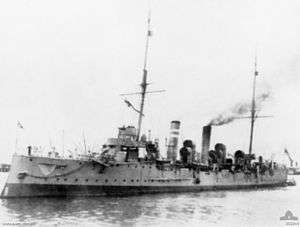HMS Prometheus (1898)
 Prometheus at Port Melbourne circa. 1913 | |
| History | |
|---|---|
| Name: | HMS Prometheus |
| Namesake: | Prometheus |
| Builder: | Earle's Shipbuilding, Hull |
| Laid down: | 1897 |
| Launched: | 20 October 1898 |
| Fate: | Sold for scrap, 28 May 1914 |
| General characteristics | |
| Class & type: | Pelorus-class cruiser |
| Displacement: | 2,135 long tons (2,169 t) |
| Length: | |
| Beam: | 36 ft 6 in (11.13 m) |
| Draught: | 16 ft (4.9 m) |
| Propulsion: | Triple expansion engine, 2 shafts, 5,000 ihp (3,728 kW) |
| Speed: | 20 knots (37 km/h; 23 mph) |
| Complement: | 224 |
| Armament: |
|
HMS Prometheus was a Pelorus-class protected cruiser of the Royal Navy. There were eleven "Third class" protected cruisers in the class, which was designed by Sir William White. While well armed for their size, they were primarily workhorses for the overseas fleet on "police" duties and did not serve with the main battle fleet. She was sold for scrap in 1914.
Construction and armament
The Third class cruisers displaced 2,135 tons, had a crew complement of 224 men and were armed with eight QF 4 inch (102 mm) (25 pounder) guns, eight 3 pounder guns, three machine guns, and two 18 inch (457 mm) torpedo tubes. With reciprocating triple expansion engines and a variety of boilers, the top speed was 20 knots (37 km/h).
HMS Prometheus was laid down at Earle's Shipbuilding, Hull, in 1897, launched on 20 October 1898, and moved to Sheerness to be fitted with arms in 1899. She was completed in early January 1900 and transferred to the Medway Fleet Reserve,[1] from which she was commissioned in 1900.
Service history
Commander Frederick W. F. Hervey was appointed in command in August 1901,[2] and commissioned the ship at Chatham 25 September 1901 to serve in the Channel Squadron.[3] Commander F. C. T. Tudor was appointed in command in early 1902,[4] when she had propeller trials at Portsmouth.[5]
Promotheus was sold for scrap on 28 May 1914.
References
- ↑ "Naval & Military intelligence" The Times (London). Wednesday, 17 January 1900. (36041), p. 9.
- ↑ "Naval & Military intelligence" The Times (London). Saturday, 31 August 1901. (36548), p. 4.
- ↑ "Naval & Military intelligence" The Times (London). Wednesday, 4 September 1901. (36551), p. 8.
- ↑ "Naval & Military intelligence" The Times (London). Thursday, 16 January 1902. (36666), p. 7.
- ↑ "Naval & Military intelligence" The Times (London). Monday, 10 March 1902. (36711), p. 6.
| ||||||||||||||||||